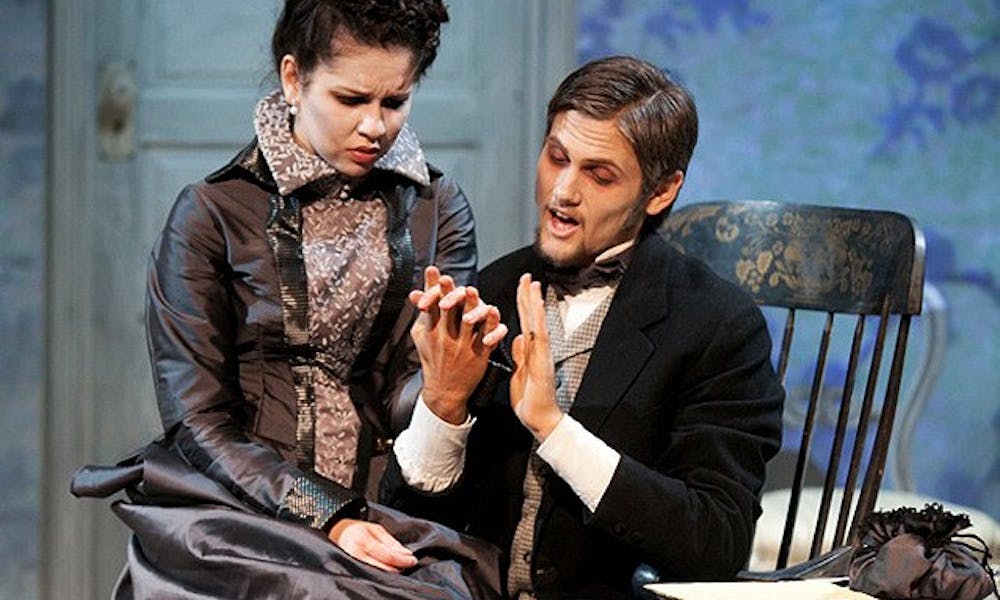The elegantly dressed man appears from the shadows and examines his massive gift, wrapped in concealing cloth and a wide scarlet ribbon. Slowly, carefully, he tears down this wrapping, enters his house and adjusts two life-sized dolls—one dressed and posed like a wife, the other like a maid. He disappears once again in shadow.
The Theater Studies mainstage production of Henrik Ibsen’s A Doll’s House opened last weekend in Sheafer Theater, darkly casting the classic tale of a wife breaking free from her husband’s world in a production of surreptitious gestures, eerie music and shadows on the wall.
When the play debuted in 1879, it shocked audiences with its portrayal of a woman eventually breaking out of the confined role that society and her husband allowed her. Today, when A Doll’s House has become standard reading for high school English classes, the story may not be quite so shocking. But director Ellen Hemphill, director of undergraduate studies and professor of the practice of theater, described its continuing relevance.
“[It’s about] how they interact—it’s a kind of hyper world of ‘I’m the boss and you’re my little girl,’” she said. “I think this type of communication does still exist in couples and it might be a choice or mutual agreement of interaction, or it might be emotional abuse.”
The opening images of the gift-wrapped house and the poseable women set the tone for the symbolic richness of the production’s gestures.
“It’s Torvald’s world, he unwraps his world, he puts the people in place, he keeps the world ordered and it’s the breaking apart of that ordered world which is the theme of the piece,” Hemphill noted.
Hemphill developed the production with a gestural theater approach, focusing first on the physicality of the characters. For the first few rehearsals, before looking at the script, the actors drew on their own habits to develop three gestures that they do without noticing, and built a repertoire of gestures ranging from imitating a small animal to looking behind their backs as if someone just called their names. These gestures formed a physical palate that the actors later pulled from.
“All of our gestures were Jenny gestures or [actress Jamie Bell] gestures. It was never Nora or Mrs. Linde,” Jenny Madorsky, who plays Nora, said. “Once we developed those, then, all of a sudden, we started adapting them to the character, so it was kind of the character stepping into our shoes as opposed to the other way around.”
Madorsky recalled one instance of gesture work in which Hemphill played a particularly emotional song and asked Ali Yalgin and Jamie Bell, who play the unrequited lovers Krogstad and Mrs. Linde, to perform their gestures on each other—instead of touching their own ear, they would touch the other’s ear.
“It was incredible, we were all in tears after it, because it was like a conversation between two people with no words,” Madorsky said. “It was so touching and all the sudden the chemistry was there, the relationship was there, before we had done anything with words at all.”
The other production elements build on the gesture-inspired action to produce a brooding atmosphere of deceit and suspicion. The actors wear heavy make-up: five layers adding up to a matte of whiteface with dark raccoon-like eye-shadow. The actors arrive backstage two-and-a-half hours before each show for the extensive make-up and hair process. Bell said the make-up helps frame the world of the play.
“It’s sort of similar to the mask theory. While people are still able to relate to the characters, it does take them into a completely different world, a completely different context,” she said.
Hemphill also worked with long-time collaborator Allison Leyton-Brown, starting six months before the show to compose an original score. The music echoes silent black-and-white movie scores of the 1920s. Upright bass, piano, clarinet, flute and a theremin—a wavering, wailing instrument that sounds eerily like strings or a human voice—bolster the jagged and churning atmosphere.
Jim Haverkamp contributed video art to the production. At times throughout the show, supple black-and-white projections of the characters hover like shadows on the walls, interior monologue turned to wallpaper. The mystery of these images evokes the atmosphere of deception. The central character in this house of cards is Nora, who maintains a household built on a fraudulent and illegal transaction.
“Nora actually is very smart and very cunning. She lies a lot,” Madorsky said. “What [dramaturg Jules Odendahl-James] said is Act One is all about lies, it’s about this illusion that Nora creates and lives in. And I really connect that to the house, so every time Nora talks about this beautiful home I imagine it as this beautiful web of lies that I’ve built and that I live in.”
Nora’s lilt carries her role as a happy wife until a lowlife stranger brings to light hidden details from her past. As the illusion of familial satisfaction explodes, so does Nora’s façade, in one of the most jarring moments of the show.
The gestural acting undergirds the expression of the show. The actors do not broadcast their gestures, they simply perform them, with an authenticity that comes from moving within a character. Something sinister is afoot in the house of Torvald, and everyone’s movements are complicit.
A Doll’s House continues its run with performances at Sheafer Theater in the Bryan Center at 8 p.m. on November 17-19 and at 2 p.m. on November 20.
Get The Chronicle straight to your inbox
Signup for our weekly newsletter. Cancel at any time.

